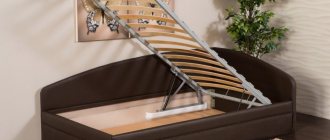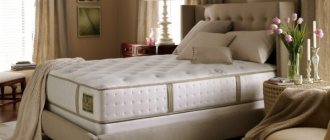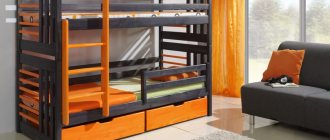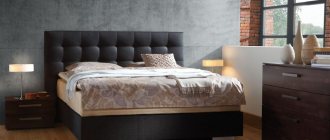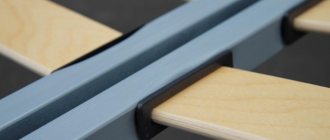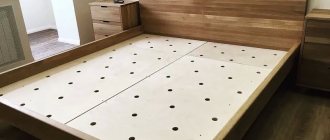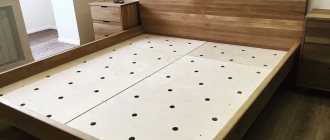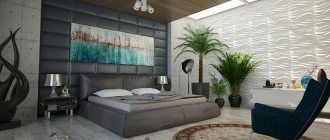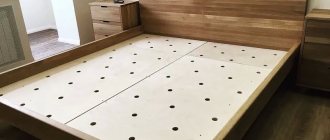What is a bed base
A bed base is a mattress support and is essentially the bottom of a bed. The base can be made in the form of a continuous sheet, which is made from boards, plywood, or chipboard. This type of base is heavier in weight and less mobile. The main disadvantage is that a mattress on such a base will not be able to fully demonstrate its orthopedic properties. Accordingly, the quality of sleep also deteriorates.
The orthopedic lattice is an improved type of base. The structure consists of a frame and elastic shock-absorbing lamellas (planks) made of wood and special fastenings.
Solid base: pros and cons
It consists of boards or a sheet of plywood laid on a frame. Despite the fact that they are seriously inferior to rack and pinion ones, they are still found in models because:
- The design is very simple, so they are cheaper.
- Any mattress can be laid on such a base.
- For diseases of the spine, a solid foundation is recommended.
However, there are still more disadvantages to such a foundation:
- The mattress sag and sag faster on a hard base. This does not apply to a good spring mattress.
- The bottom can break under the weight of an obese person or from a child jumping.
- It is hard to sleep on such a bed, especially if the mattress is quite thin. However, if you have a good orthopedic mattress, then this drawback is completely eliminated.
- The heavy weight of the bed makes it difficult to transport. On the other hand, a bed is not a handbag that needs to be carried around with you or constantly moved from place to place.
In addition, hard bases impede ventilation, which can lead to the growth of microorganisms in the mattress. True, now manufacturers are making ventilation holes in rigid bases, and this problem has almost been eliminated.
Rigid bases are either a sheet of plywood or chipboard, or wooden boards. People choose them not only to save money - they are cheaper, but also to avoid problems with the spine. In this case, it is healthier to sleep on a hard, flat bed. Doctors believe that a rigid base plus an orthopedic mattress is the optimal tandem.
What does the bed base consist of?
If everything is clear with a solid base for a bed: it is a plywood sheet or boards attached to the bed frame, then the structural features of the orthopedic lattice should be examined in more detail and find out which base for the bed is better.
A slatted orthopedic base is much more complex in its configuration than a solid base for a bed. It is made of straight or concave slats placed at a short distance from each other. The lamellas are attached to the frame using special fasteners - mortise or overhead lat holders. Lat holders are made of rubber or plastic.
Rubber holders provide a springing effect, which gives the bed base a “soft” feel. But if a high mattress of 20 cm or more is used, then this becomes noticeable.
The slats are made from beech, birch and pine wood. It is the properties of wood that give the lamellas different levels of elasticity and reliability. Beech slats are characterized by increased strength and elasticity; their price will be more expensive than their budget counterparts. Such lamellas can withstand even high loads. For people of average weight or teenagers, bases with birch or pine slats are suitable.
Dimensions
If you intend to purchase a single bed, then the dimensions of the base must correspond to the dimensions of mattresses with a width of 80-90 cm and a length of 190-200 cm. However, you can also order orthopedic bases of non-standard sizes.
The standards for a sleeping place designed for two people are usually 160x200 mm. When choosing a spacious double bed with an orthopedic effect, it is preferable to choose a model with dimensions of 180x200cm or 200x200cm.
Important! The larger the size of the base, the more additional legs there should be in addition to the standard 3 in the corners. The optimal number of such additional legs is from 1 to 4.
Types of bases
Lattice or orthopedic bed bases have various modifications. There are different types of bed bases according to the following parameters:
- Frame type. Manufacturers make metal bases that can last for decades, plastic and wooden grilles.
- Presence of legs. The lattice can be an independent structure on legs or made in the form of separate slats that are installed in the bed structure.
What types of bed bases are there:
- Collapsible. This design is convenient to transport. It consists of the following elements: frame, lamellas (slats), lath holders and legs. The structure is easy to assemble according to the instructions. The orthopedic properties of the base are preserved.
- Solid bases. Ready to use variety. They are produced solid or in the form of an orthopedic lattice made of wood or metal.
- Lifting. These models have a lifting mechanism (manual, gas, spring) that raises the base and provides quick access to the drawers under the mattress. The design will be convenient for small bedrooms and saves space.
- Frameless (liners). They are a tape of lamellas fastened together. The mobile design does not have legs or lathe holders. Installing such a base is very simple - just insert the flexible structure into the bed frames.
- Transformable. This is a premium orthopedic lifting bed base. Thanks to a special mechanism, the transforming base can be adjusted taking into account the position of the body. The structure is lifted by manual adjustment or by remote control. So, for reading or watching TV shows, the head of the bed can be raised. The lower part of the base also rises for a comfortable position of the legs.
- With adjustable hardness. For comfortable use of the base, a design with the ability to adjust rigidity has been created. If you are faced with the question of which bed base to choose, we recommend that you pay attention to this option. Using special attachments on the lamellas, you can change the rigidity of the base, taking into account specific requirements and health conditions. For example, add rigidity structures in the lumbar region. In some models, each slats can be adjusted.
Let's pay special attention to the slats:
Lamels are bent-glued plates (battens) made from flexible wood species: birch, walnut and beech.
Lamels are bent-glued plates made from flexible wood species: birch, walnut and beech.
If we compare price and practical properties, then birch armor is the best option. But they are inferior in terms of technical indicators to planks made from more valuable types of wood, since they are less durable and can withstand smaller weight loads at a point.
Beech slats at the base are more practical.
The slats are attached to the frame with lath holders. These are very important structural elements that are responsible for reliable fixation of the lamellas and the absence of surface creaking. They are made of plastic (budget), polypropylene and rubber (expensive, because they are more durable than plastic and create an additional orthopedic effect).
Lamella holders are very important structural elements that are responsible for reliable fixation and the absence of squeaking of the surface.
The metal frame is reinforced with a central frame, also made of high-strength alloy. Please note: plastic lamellas can be classified as a special category. Their supports are fixed on spring elements, due to which the structure itself has orthopedic qualities. Some models are equipped with additional options for massage. The position of their headboards and footboards is adjusted by electric drive or remote control.
Plastic slats are fixed to spring elements, due to which the structure itself has orthopedic qualities.
In this regard, beds are much more expensive and require special springless latex mattresses.
In order for the bed to be light, elastic, interact effectively with the orthopedic mattress and give the sleeping person’s body an anatomical position, it is necessary to comply with the standards for the manufacture and location of the slats.
Latoflex standards (lamellas):
The lamellas can be wide (designed for mattresses with a Bonnell or “springless” spring block). And narrow (suitable for all types of mattresses, especially for coverings with independent springs, “multi-pockets”).
The slats can be wide or narrow.
With recommended slats widths from 60 to 63 mm. their thickness ranges from 6 to 8 mm. The length varies according to the dimensions of the base. The distances between the slats are from 70 to 80 mm. significantly improves the orthopedic properties of the base. The optimal number of lamellas is from 20 to 30 pcs.
According to experts, the more latoflexes, the more comfortable and durable the base.
Types of lifting structures
- Manually lift the base securely. The mechanism has a long service life compared to others. But when lifting, you have to hold both the base and the mattress with linen. Which, you see, is not very convenient;
- The spring model rises “with effort”, although it holds the surface of the bed well. Over time, it must be replaced due to stretching of the springs;
- “Gas lifts” (gas shock absorbers) cope well with the task. They operate smoothly and silently. True, over time the filler may leak;
- The leader among lifting structures is an electric drive mechanism. But among those listed, it is also the most expensive.
Option of the base with a lifting mechanism “Gas-lift”.
At the factory, orthopedic bases for the bed are tested for strength, so the lattice of wooden slats can withstand the load of a large human body.
Among other advantages, beds with a separate orthopedic base are mobile! Which is a huge plus when rearranging or moving. This saves space when loading, and also makes it easier to take furniture out and into the room (especially with narrow doorways)! By separating the legs, sleeping area, upper base with latoflexes (slats), headboard and footboard, the bed can be loaded even into a passenger car without any effort.
Among other advantages, beds with a separate orthopedic base are mobile.
When purchasing a bed with an orthopedic base, pay close attention not only to the appearance of the product, but also to its “visible” components:
- On slats (latoflexes) cracks, knots and brown spots in the form of a hollow are unacceptable (this indicates a poorly cut knot. After some time, a hole forms at the place of the cut);
- Ask the sales consultant to tell you about the material and method of fastening the armor;
- The metal frame must be evenly painted, without rust or chips;
- Loose fastening points and “technical holes” in a wooden frame are a sign of defectiveness;
- If possible, purchase a mattress and bed from one manufacturer that has proven itself in the sleeping products market (For example, Ascona, Ormatek, Dream Line);
When purchasing a bed with an orthopedic base, pay close attention not only to the appearance of the product, but also to its components.
The disadvantages of slatted bases include:
- The mattress must be turned over every few months to avoid sagging between the strips. This is due to the lack of fastenings between the lamellas;
- Latoflexes lose their shape and elasticity over time. They jump out of the lath holders;
- They do not have a system for attaching the mattress to the slats and require the use of unsightly restraints.
Orthopedic base
Many buyers wonder why a bed base is needed if an expensive orthopedic mattress is purchased along with the furniture. Are the additional costs for purchasing an orthopedic base justified?
What is an orthopedic bed base and why is it better than other types of bed bases? An orthopedic base is a special design made of a frame and lamellas, with the help of which the orthopedic qualities of a mattress placed on this base are enhanced.
The slatted orthopedic base, due to its shock-absorbing properties, allows you to create an ideal platform for an orthopedic mattress. This is the best base for a bed because it provides the sleeper with a beneficial effect on the spine, back and neck muscles. Promotes proper rest and restoration of the body.
Chipboard bunk bed - assembly instructions
A bunk bed is popular in families with two or more children. The technique of constructing such structures with your own hands is not much different from the single-bed version. The difference is that the back panel and two side panels are made higher and on their basis a similar bed is built under the same mattress.
Scheme of a bunk bed with drawers.
- You already know how the lower bed is constructed; the upper structure rises to a height of 1355 mm on three sides.
- A mattress shield is placed on top of the supports, but you will install it later; first, the assembly is assembled on the floor. To do this, limiters with a height of 300 mm are installed on the confirmats on 3 sides (side parts and headboard). At the feet, a 100 mm high bar is sufficient.
- Now the upper box is installed on the base and fixed at several points with two stiffening ribs. One front rail for the entire length of the bed and one support on the back side. Theoretically, 2 stiffening ribs are enough, but I recommend installing a couple more cross members.
- At the end, an attached ladder is attached to the main structure; it is also assembled from laminated chipboard onto confirmats.
Advantages of an orthopedic base
An orthopedic bed base has a number of advantages compared to a solid base made from a plywood sheet. Over time, the plywood base is pressed under the weight of the sleeper. This does not happen with orthopedic bases due to the convex lamellas, which provide resistance to the applied load. Due to the shock-absorbing lamellas, an additional orthopedic effect is created and the mattress does not deform in areas of the highest pressure.
Orthopedic bases from a high price category are made of beech wood, which is characterized by increased elasticity and durability. Manufacturers use original technologies in the manufacture of such bases, for example, installing double lamellas to enhance elasticity and better load distribution. This provides the sleeper with quality support.
The undoubted advantage of bases with an increased number of flexible elements per unit area is an orthopedic supporting effect, unloading of the spine, comfort and convenience during sleep. The mattress and the base duplicate the relief of the body, providing maximum comfort and complete rest.
The use of double slats equipped with a slider-regulator will allow you to manually add the required level of rigidity to the sleeping area. Choosing a bed base with wide slats is recommended for overweight people. Manufacturers also offer bases with the possibility of differentiated support for several sleeping areas.
The choice and arrangement of your sleeping place must be approached carefully. Think through everything down to the smallest detail. It is important that the air in the room is clean and fresh, and that the mattress is suitable for you. Every single detail of the bed matters, in particular its base. If it is unreliable, then even the most expensive mattress will not save your restful sleep. Today, the Anatomy of Sleep review is dedicated to the types of bed bases, their features, advantages and disadvantages.
What is a bed base?
The bed base is an inconspicuous and very important part of the entire structure, because it is responsible for whether you will be comfortable while sleeping. Also, few people know that the service life of the mattress depends on the base. A poor-quality base eliminates all the beneficial properties of the mattress.
The bases are made of wood, metal and plastic. Essentially, it is a lattice with transverse and/or longitudinal bars or a solid sheet of plywood on which the mattress is placed.
There are also products without this component. But what does a bed without a base mean? A bed without a base is a wooden or metal frame with a backrest, to which you can order any base you like and that suits you. Nowadays such furniture is popular because it allows you to choose an individual base depending on many personal aspects: weight, age, health or, for example, the characteristics of your mattress.
What types of bed bases are there?
- orthopedic base - in the form of a frame made of slats, the so-called lamellas;
- solid or continuous bases - monolithic or glued block from boards/sheets of plywood.
Orthopedic bases consist of individual lamellas of different widths. The slats can be attached singly, in twos or all in a row on a special textile furniture tape. But more on this a little later.
A solid or solid base is usually made from sheets of plywood or boards. Any type of mattress can be used with a solid base, but it must be remembered that due to the rigidity of the structure, the orthopedic properties of the mattress may be reduced. A smooth and rigid solid base is useful for the prevention of certain spinal diseases.
Now let’s try to figure out which bed base is better. After all, everyone who chooses a bed must answer this question for themselves - the quality of the base largely determines the comfort of sleep and the service life of the bed. If a sheet of plywood breaks due to heavy load, the entire base will have to be replaced. But if one or two lamellas break, they can be easily replaced individually.
But there are other factors that affect the quality of sleep and rest: body weight, mattress weight, its hardness, breathability and much more.
What is an orthopedic bed base and which base is better?
An orthopedic bed base consists of a frame and the slats themselves. Frames are made from metal and wood. As a rule, slats are made from walnut, beech and birch. Beech slats are the most expensive, birch slats, on the contrary, are the most budget models. Moreover, all slats made of beech, pine or birch provide an equally good spring effect.
Some orthopedic bases have legs, which are additional supports for greater reliability. The legs of the base can be either removable or built into the structure.
The lamellas of the orthopedic base come in different widths and are located at different distances from each other. Thanks to this, orthopedic bases allow air to pass through better than solid structures. If the air exchange is good, then the sleeper’s skin and favorite mattress will “breathe.” Do not forget that the greater the distance between the slats, and the narrower they are, the greater the load on the mattress and, accordingly, the faster it wears out. Typically, the lamellas are spaced from each other at a distance of 3 to 6 cm. If this figure is greater, it is not recommended to consider such a structure as a full-fledged base. Most often, for a standard bed with a length of 190 cm, manufacturers make a base with 15 slats or more.
The rigidity of the sleeping area depends on the distance between the slats. The proportion is the opposite: the smaller the distance between the lamellas, the higher the rigidity. Take this into account when choosing a slatted base for your bed. A more rigid base can enhance the orthopedic properties of the mattress, provide additional support for the spine, and if the lamellas are sparse, then the springs can “fail” and the useful properties of the product can be lost.
The advantage of the slatted base is its ease of repair. As mentioned earlier, if one part fails (usually one lamella is designed for 12 kg of load), it can be easily replaced.
Who is suitable for lamellas, and for whom a solid base?
The choice of orthopedic base depends on the individual characteristics of the sleeper.
- For overweight people, a rigid orthopedic base with wide slats and a small distance between them (up to 6 cm) is suitable.
- People with spinal diseases should pay attention to Multilamel. It makes it possible to adjust the rigidity of the bed under different zones: cervical, lumbar, pelvic, etc. The distance between the slats in it is 4 cm or less. Such bases are also recommended for couples with a large weight difference. It will also significantly extend the life of the mattress.
- Solid bases are heavier, but no less reliable. People with a lot of weight should take a closer look at them. It is also recommended to choose solid bases when using heavy mattresses or springless models with a high layer of natural latex or memory foam that follows the contours of the human body. A solid base will enhance the “memory” and “immersion” effect.
What to consider when choosing a bed base
So, when choosing a base for a bed, decide on the following aspects:
- Who will sleep on the bed? Consider the weight, age, and health status of the sleeper. The choice of base will depend on this.
- Pay attention to what kind of mattress will be placed on the bed: spring or springless, light or heavy, do not forget about the type of filler. If the mattress is spring, a maximum distance of 6 cm is allowed between the slats of the orthopedic base. A solid base is suitable for heavy mattresses, and for orthopedic models of low mass it is better to choose slatted bases with the same properties. Such bases, like mattresses, follow the relief of the body and provide additional support to the spine.
- The main parameter when choosing a base for a bed is the load on the bed. Calculate it by adding the mass of both sleepers and the mattress and dividing by two. When choosing a base for a bed, experts recommend choosing models with a reserve: load per bed plus 10-20 kg.
Choosing a bed base
Experts from the Mister Slip online store in Moscow tell you how to choose a base for a bed.
- If you need to arrange a temporary sleeping place, for example, in a rented apartment or country house, give preference to products with wide slats and mortise-type lath holders. These designs are distinguished by the most affordable price.
- To equip a permanent bed, pay attention to bases with narrow slats and rubber lat holders. These models represent the optimal combination of comfort, versatility and reasonable cost.
- To create the most comfortable sleeping place, bases with expanded functionality and the ability to adjust rigidity are recommended. By individually adjusting the degree of comfort for a specific zone or several zones, the body recovers faster during sleep and improves well-being.
- For those who prefer progressive solutions, manufacturers offer motorized base options. The owner of such a design will have the opportunity to ensure maximum control over a comfortable body position without effort and without even getting out of bed.
The benefits of making it yourself
The idea of making a bed with my own hands came to me when I started looking at finished products. At first there were doubts, but then the advantages of this option outweighed all objections.
- Our man is used to doing everything with a triple safety margin, so by assembling a bed for your loved one, you get a product that will stand until it becomes obsolete.
- Additional options such as drawers at the base of the structure or a shaped headboard are made at will and are several orders of magnitude cheaper than custom ones.
- The range of colors, shades and textures of furniture laminated chipboard includes hundreds of options, so there will be no problems with the design.
The choice of colors and textures of furniture laminated chipboard is impressive.
- At a professional level, assembling a bed with your own hands is considered a simple task, but such work provides invaluable experience and then you can move on to more complex designs.
- And finally, the main thing is that the price of a decent single bed with drawers starts from 20 thousand rubles. (excluding the cost of the mattress), and the material for the same homemade product will cost 7 thousand rubles, plus 1 day for assembly. As you can see, the difference is obvious.
On the market, the cost of a normal bed with drawers starts from 20 thousand rubles.
What is the material
Laminated chipboard is a material made from natural wood. It is a chipboard, but with higher quality sanding and applied with a melamine film. The main difference is the coating that is used in the board during pressing. This addition makes the material more durable and moisture resistant. The price of loose raw materials is low, but the design, thanks to the coating, can be very diverse (with wood patterns, different colors).
Manufacturers strictly monitor the safety of the material, bringing the percentage of formaldehyde to a minimum. Some classes of laminated chipboard are not inferior to natural wood in terms of environmental friendliness.
The textures of the material can be as follows:
- vector patterns;
- geometric;
- ornaments;
- imitation of natural wood.
Unfortunately, the material has significant drawbacks. It releases toxic formaldehyde into the air as resin is absorbed into the decorative coating. The way out of the situation is lamination, which is a film of paper with decor with a density of 60-90 g/sq.m. Lamination is the placement of a coating under high pressure and the influence of temperature. The process is carried out in a press, where the paper is made very dense, like plastic. A glossy film appears in the upper part, and in the lower part too, but with the presence of glue. The coating is durable, the resin spreads over the surface of the particle board under a pressure of 25-28 MPa and at temperatures reaching 210 degrees. When laminating, harmful aldehydes do not evaporate from the material.
The chipboard from which beds are made has many advantages:
- safety - the material made from shavings and sawdust as a binder contains formaldehyde, which is harmful to humans. Due to the laminated layer, laminated chipboard does not emit harmful substances;
- rigidity, strength of the material - laminated film is made from paper with the required structure. A high level of rigidity and the necessary friability are achieved by impregnating it with melamine resin. Pressing connects the boards with the film and produces a material of standard thickness;
- resistance to mechanical and thermal damage. The material rarely suffers from scratches or chips; it is not afraid of temperature changes and the touch of hot objects;
- easy care - products do not require special care products. It is enough to wipe the bed with a damp sponge to make the product clean;
- moisture resistance - melamine film reliably protects the structure of the particle board from moisture, protecting the material from rotting and mold formation;
- affordable cost - products are cheaper compared to models made of natural wood.
Along with positive qualities, there are also disadvantages. Laminated chipboard cannot be finely processed, and the presence of formaldehyde is also a disadvantage.
